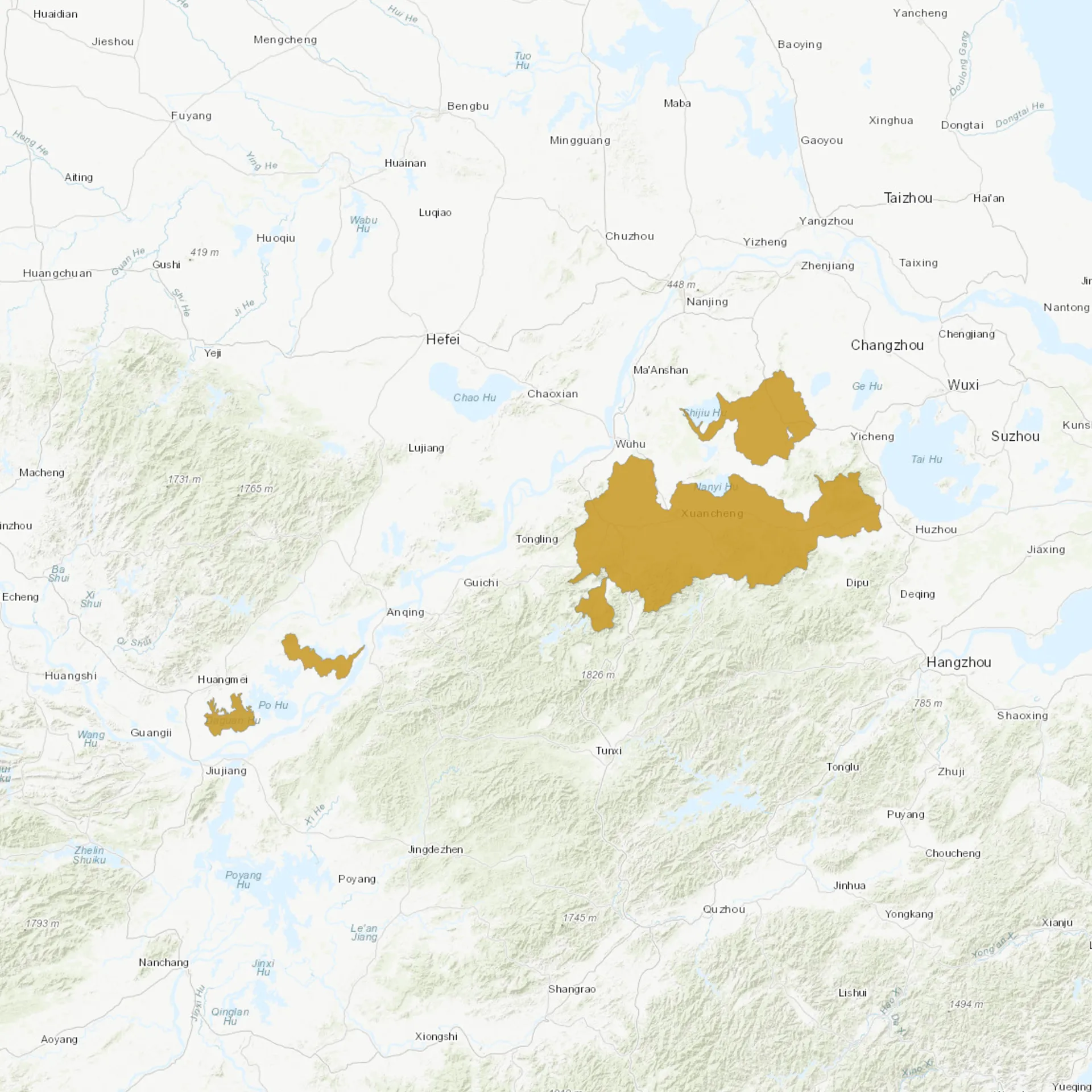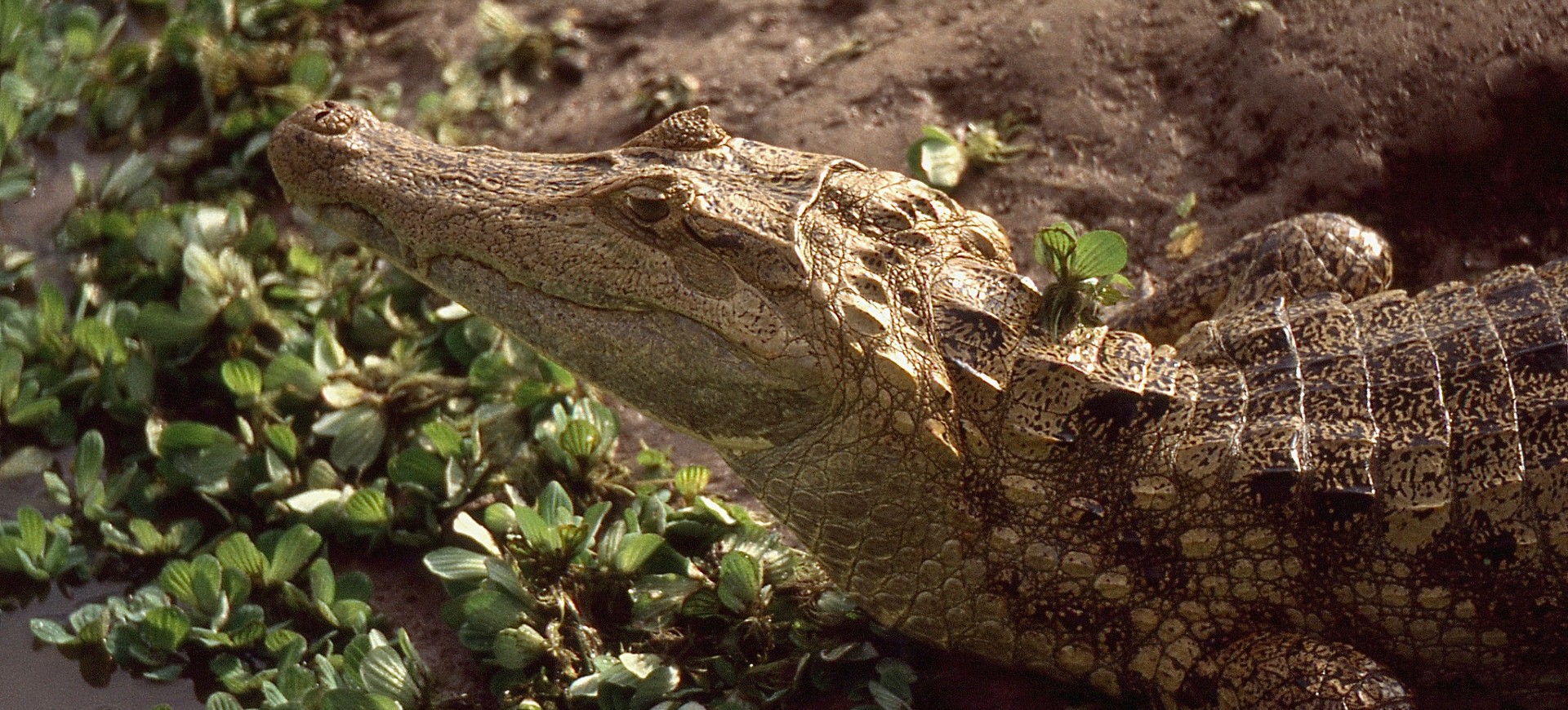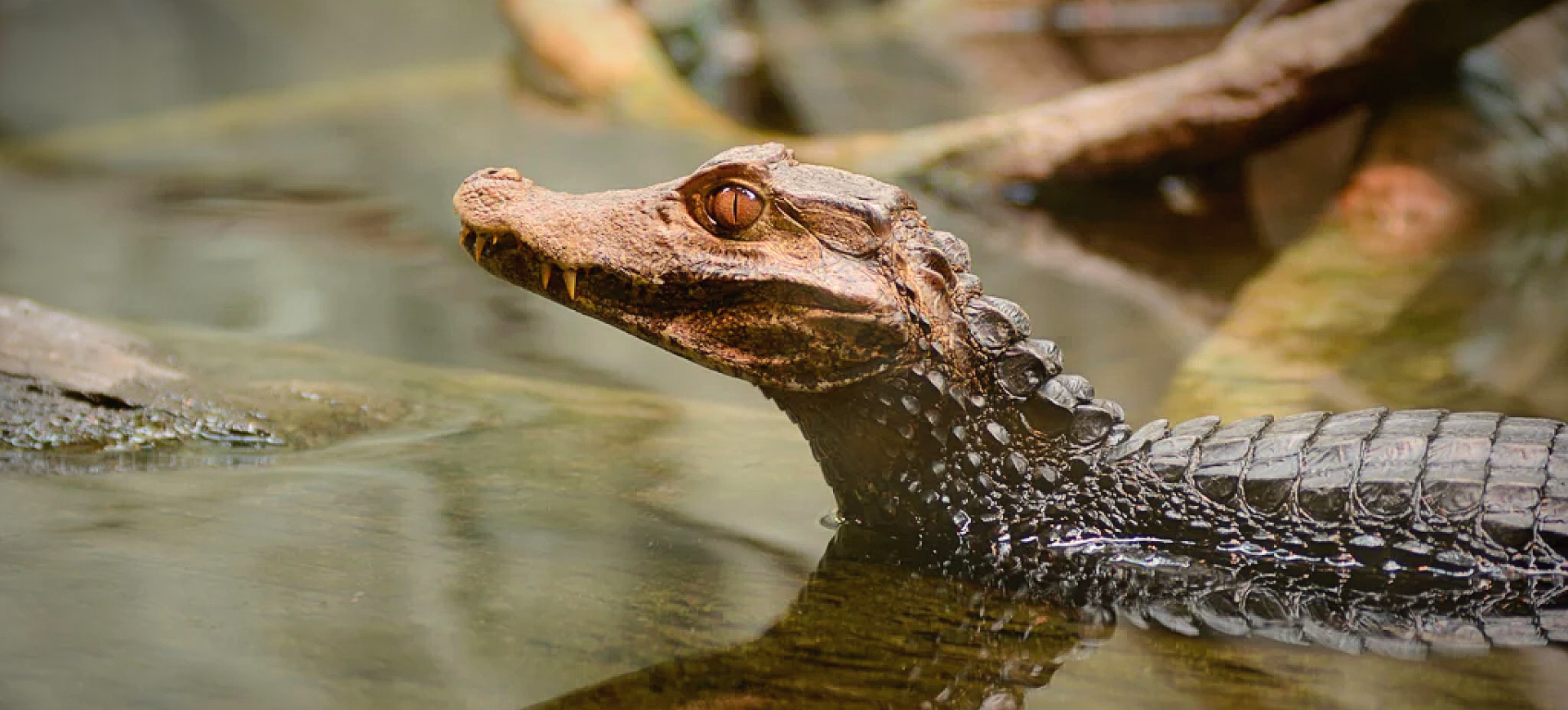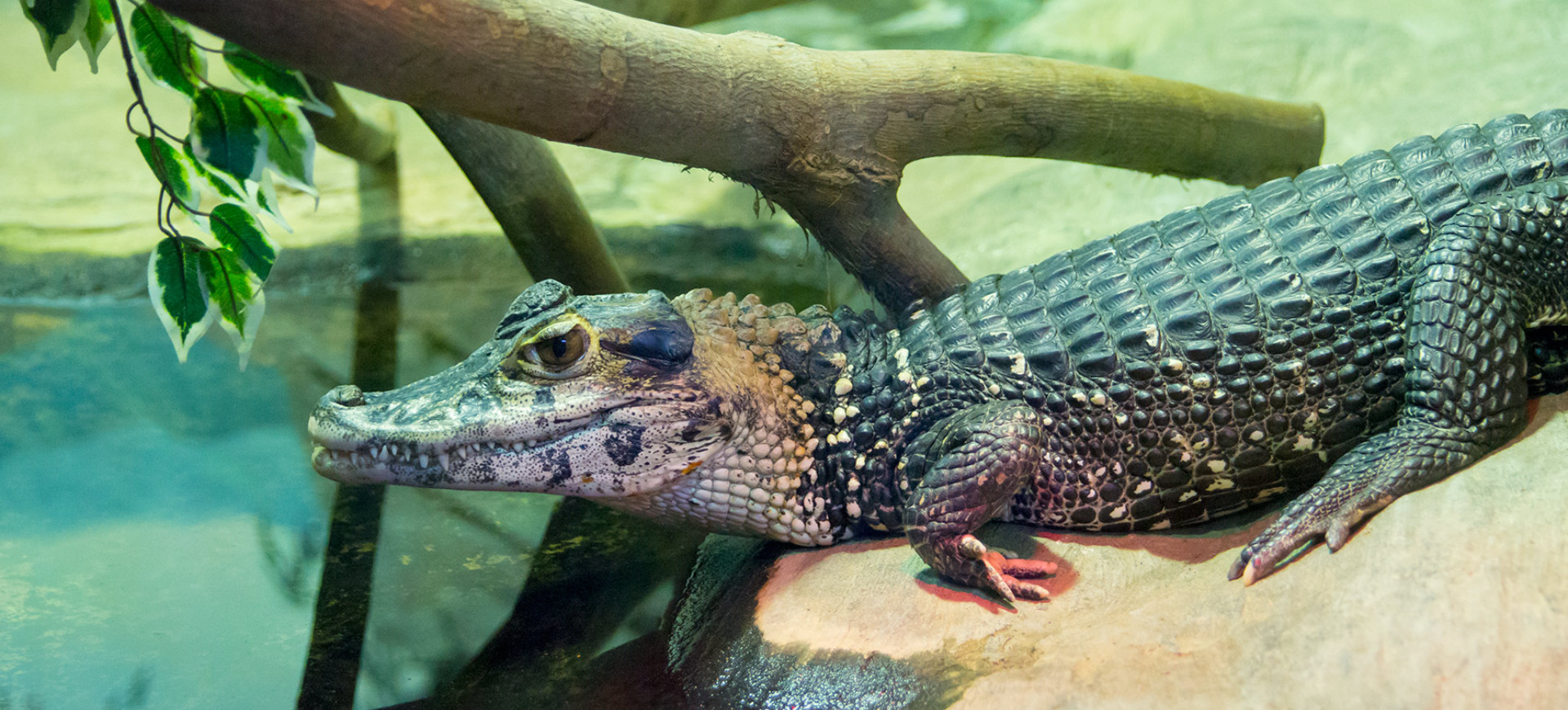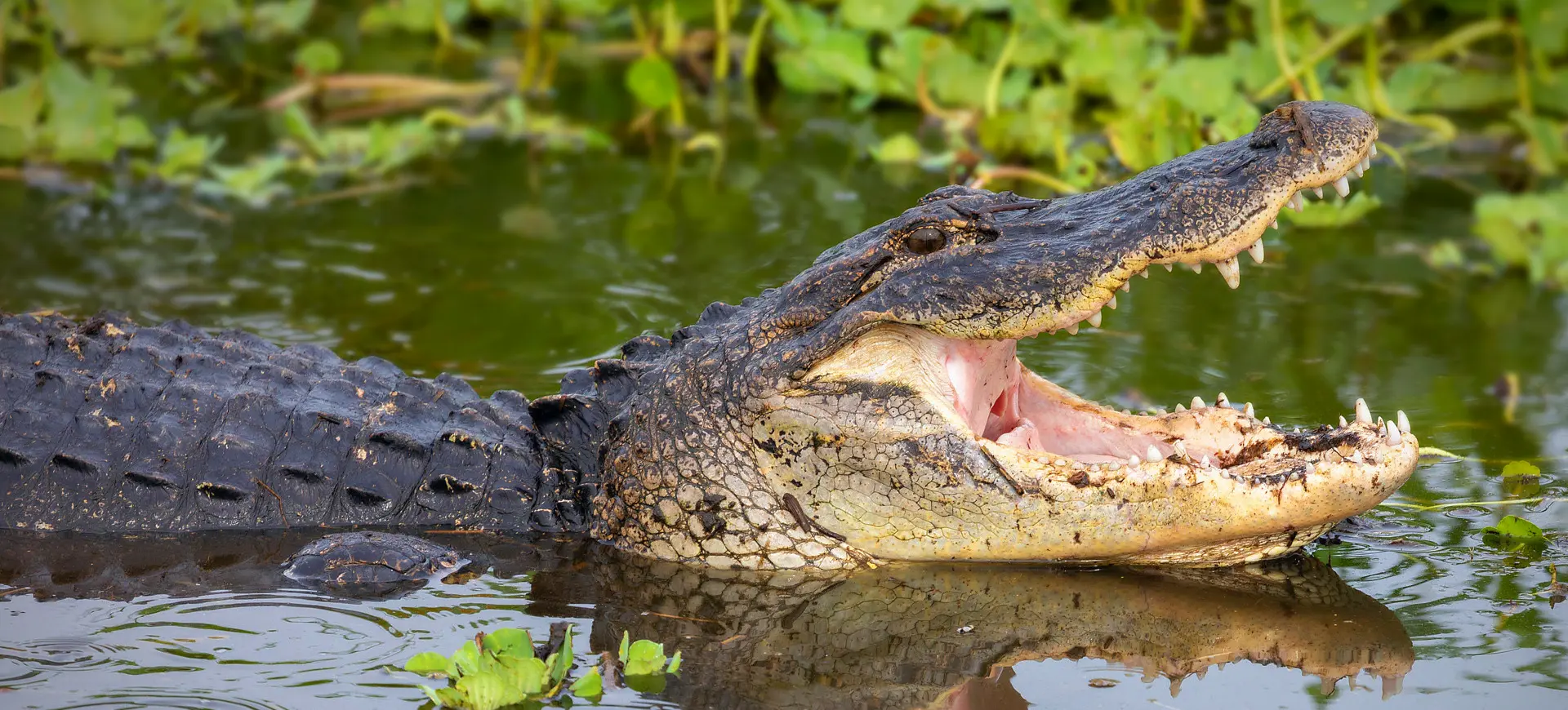Overview
The Chinese alligator (Alligator sinensis) is a small, rare crocodilian species native to the freshwater wetlands of eastern China. Unlike its larger relative, the American alligator, this species is much smaller and is known for its heavily armored body, which includes bony plates covering its back, tail, and even parts of its belly. It primarily inhabits slow-moving rivers, lakes, and marshes, relying on dense vegetation and burrows for shelter. Due to habitat loss and human activities, it is now one of the most critically endangered crocodilians in the world.
This species is largely nocturnal, spending much of the day hidden in burrows and becoming active at night to hunt for prey. Its diet consists mainly of fish, amphibians, insects, and small mammals, with occasional consumption of mollusks and crustaceans. Chinese alligators are ambush predators that use their strong jaws and sharp teeth to capture prey efficiently. Despite their small size, they are highly adapted to their environment and have remained relatively unchanged for millions of years.
Once widespread across the lower Yangtze River basin, the Chinese alligator’s range has been drastically reduced due to agricultural expansion, pollution, and dam construction. It is confined to a few small reserves in Anhui Province, where conservation efforts focus on habitat restoration and captive breeding programs. Although reintroduction efforts have shown promise, wild populations remain critically low. Strict legal protections and ongoing conservation initiatives are essential for preventing the extinction of this ancient reptile.
Taxonomy
Kingdom
Phylum
Class
Order
Family
Genus
Species
Type
Current distribution:
Once widespread across the lower Yangtze River basin, the Chinese alligator's distribution is restricted to a small area in Anhui Province, China. Most of the remaining wild population is found in protected reserves, where conservation efforts aim to prevent further decline. Due to habitat loss and fragmentation, wild alligators are rarely encountered outside of these protected areas. Some individuals have been reintroduced into restored wetland habitats, but their long-term survival remains uncertain.
The wild population is estimated to be fewer than 150 individuals, making it one of the most endangered crocodilian species. In contrast, thousands of individuals exist in captivity, both in breeding centers in China and in zoological institutions worldwide. Efforts to expand reintroduction programs are ongoing, but habitat degradation remains a major obstacle. Continued conservation action is critical to ensuring that wild populations do not disappear entirely.
Physical Description:
The Chinese alligator is a relatively small crocodilian, with adults reaching an average length of 5 to 7 feet (1.5 to 2.1 meters). Its body is covered in dark gray to black scales, with a slightly lighter underside, providing effective camouflage in murky freshwater environments. Compared to its American counterpart, it has a broader snout and more pronounced bony armor, including osteoderms on its belly, providing additional protection. Its eyes and nostrils are positioned on top of its head, allowing it to remain mostly submerged while observing its surroundings.
This species has relatively short but powerful limbs, making it well-suited for digging extensive burrow systems along riverbanks and wetlands. Its tail, which accounts for nearly half its total body length, is muscular and a powerful swimming aid. Juveniles are born with yellowish bands across their bodies, which gradually fade as they mature. Unlike many other crocodilian species, the Chinese alligator is more cold-tolerant and hibernates during the winter months in underground burrows.

Lifespan: Wild: ~50 Years || Captivity: ~80 Years

Weight: Male: 72–110 lbs (33–50 kg) || Female: 66–99 lbs (30–45 kg)

Length: Male: 60–84 in (152-213 cm) || Female: 54–78 in (137-198 cm)

Top Speed: 12 mph (19 km/h) on land || 20 mph (32 km/h) in water
Characteristic:
Native Habitat:
The Chinese alligator inhabits freshwater wetlands, including slow-moving rivers, lakes, marshes, and ponds in eastern China. It prefers habitats with dense aquatic vegetation and muddy banks, which provide both hunting cover and suitable burrow construction locations. Unlike some crocodilian species, it does not rely heavily on deep water and is frequently found in shallow wetlands with abundant prey. Seasonal changes in water levels influence its movement, with individuals shifting locations as necessary to find suitable conditions.
One of its most distinctive behavioral traits is its use of burrows, which dig into riverbanks and wetland edges to provide shelter from extreme temperatures. These burrows are used for protection, resting, and hibernation during the colder months, as this species is more adapted to temperate climates than tropical ones. Human activities, including dam construction and land conversion for agriculture, have drastically reduced the availability of suitable wetland habitats. Conservation programs focus on restoring and maintaining these vital ecosystems to support wild populations.
Biomes:
Biogeographical Realms:
Continents:
Countries:
Diet:
Diet & Feeding Habits:
The Chinese alligator is a carnivore that feeds primarily on fish, amphibians, and small mammals in its freshwater habitat. It is an opportunistic predator that uses stealth and ambush tactics to capture prey, often waiting motionless in the water before striking with its powerful jaws. In addition to vertebrates, it consumes crustaceans, mollusks, and insects, which comprise a significant portion of its diet, especially in younger individuals. Unlike larger crocodilians, it is not known to prey on large animals due to its relatively small size.
During the colder months, when it enters a state of dormancy in its burrows, feeding activity decreases significantly. It can go for extended periods without food, relying on fat reserves stored in its tail. As an apex predator in its environment, the Chinese alligator plays a crucial role in controlling populations of fish and amphibians, helping maintain ecological balance. However, habitat destruction has reduced prey availability, threatening survival in the wild.
Mating Behavior:
Mating Description:
Chinese alligators are polygynous, with dominant males mating with multiple females during the breeding season in late spring and early summer. Courtship involves vocalizations, head-slapping on the water, and body movements to attract mates. After mating, females construct nests made of vegetation and mud, usually near water, where they lay 10–40 eggs. The incubation period lasts approximately 70 days, with the female remaining close to the nest to guard against predators.
Hatchlings emerge in late summer, and the mother assists them by opening the nest and gently carrying them to the water. Unlike many other reptilian species, Chinese alligator mothers provide some degree of parental care, staying near their young for a short period. The hatchlings are highly vulnerable to predation by birds, fish, and other carnivorous animals. As they grow, they become more independent, reaching maturity at around 5–7 years of age.
Reproduction Season:
Birth Type:
Pregnancy Duration:
Female Name:
Male Name:
Baby Name:
Social Structure Description:
The Chinese alligator is a largely solitary species, with individuals typically occupying their territories within wetland environments. They establish burrows along riverbanks and marshes, which serve as shelters for resting, protection from predators, and hibernation during colder months. While they generally avoid direct interaction with other alligators outside the breeding season, overlapping territories can occur in areas with limited habitat. Juveniles often remain near their birth site for an extended period but eventually disperse to find their territory.
During the breeding season, males become more territorial and vocal, using bellowing calls to establish dominance and attract females. Courtship involves a series of vocalizations, head slaps on the water, and body movements to communicate with potential mates. Unlike some crocodilian species, Chinese alligator mothers provide limited parental care, staying near the nest to guard eggs but offering little assistance after hatching. Outside of mating and nesting periods, adults prefer a solitary lifestyle, with infrequent and often competitive interactions between individuals.
Groups:
Conservation Status:
Population Trend:
The Chinese alligator population has declined dramatically due to habitat destruction, agricultural expansion, and human activities. Once widespread across the lower Yangtze River basin, it is now restricted to small, fragmented wetland reserves in Anhui Province, China. The remaining wild population is estimated to be fewer than 150 individuals, making it one of the most critically endangered crocodilian species. In contrast, captive breeding programs have been successful, with over 10,000 individuals maintained in conservation centers and zoological institutions.
Efforts to reintroduce captive-bred individuals into protected wetland habitats have shown some success, but challenges remain due to habitat degradation and competition for resources. Many of the alligators in the wild are old and have limited reproductive success, further complicating natural population recovery. Conservation programs are focused on habitat restoration, strengthening legal protections, and increasing public awareness to improve survival rates. While captive populations are thriving, the ultimate goal is to establish self-sustaining wild populations, requiring continued research and conservation action.
Population Threats:
Habitat destruction is the primary threat to the Chinese alligator, as wetlands have been drained and converted into farmland, reducing available living space. The construction of dams and irrigation systems along the Yangtze River has altered water flow, further degrading the alligator’s natural habitat. Pollution from agricultural runoff and industrial waste has also contributed to habitat loss, making many wetlands unsuitable for alligator survival. As a result, wild populations are now restricted to small, fragmented reserves, limiting their ability to expand or recover naturally.
Human-wildlife conflict poses an additional threat, as alligators occasionally venture into agricultural areas where they are perceived as a nuisance. Historically, they were hunted for their meat and skin and used in traditional medicine, contributing to their decline. Although hunting is now illegal, accidental killings and poaching still occur in some areas. Low genetic diversity within the remaining wild population makes the species more vulnerable to disease and reproductive challenges, further complicating conservation efforts.
Conservation Efforts:
Extensive conservation programs have been implemented to protect the Chinese alligator, focusing on habitat restoration, captive breeding, and reintroduction efforts. The Anhui National Nature Reserve, established in the 1980s, serves as a key protected area where wild populations are monitored and managed. Captive breeding programs, particularly at the Anhui Research Center for Chinese Alligator Reproduction, have been highly successful, with thousands of individuals bred in captivity. Reintroduction efforts have been ongoing since the early 2000s, with several captive-bred alligators released into restored wetland habitats to bolster wild populations.
Legal protections are in place to prevent further declines, with the species classified as a Class I protected animal in China, making hunting and trading strictly illegal. Conservationists work closely with local communities to promote sustainable land use and reduce human-wildlife conflicts surrounding alligator habitats. Public education campaigns aim to raise awareness about the ecological importance of the species and encourage support for conservation initiatives. Despite these efforts, ongoing habitat loss remains a major challenge, requiring continued government action and international support to ensure the species’ survival in the wild.
Additional Resources:
Fun Facts
- The Chinese alligator is one of only two living alligator species, the other being American.
- It is much smaller than its American relative, rarely exceeding 7 feet (2.1 meters) in length.
- Unlike most crocodilians, it has bony plates (osteoderms) on its belly, providing extra protection.
- This species is highly cold-tolerant and hibernates in underground burrows during winter.
- Chinese alligators can produce high-pitched vocalizations, including bellows and chirps, for communication.
- In ancient Chinese mythology, they were believed to be the inspiration for dragon legends.
- They are excellent diggers, creating extensive burrow systems that shelter and regulate body temperature.
- Due to their smaller size, unlike many crocodilians, they primarily feed on small prey such as fish, amphibians, and mollusks.
- The Chinese alligator is one of the most endangered crocodilians, with fewer than 150 individuals left in the wild.
- Successful captive breeding programs have led to over 10,000 individuals being raised in conservation centers worldwide.


